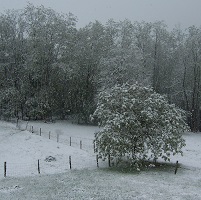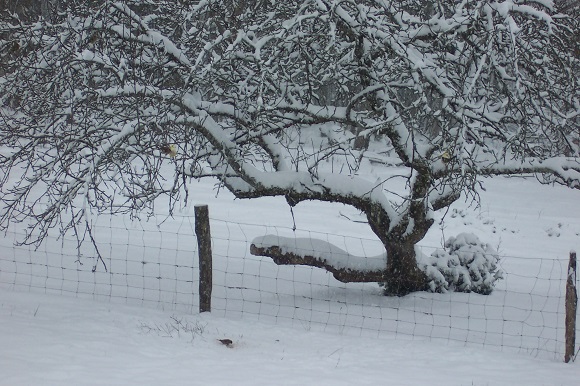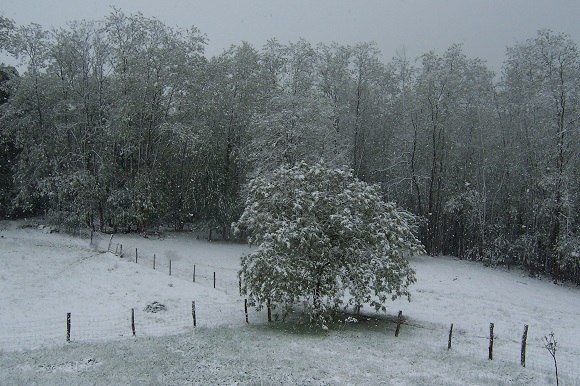
One wintery day in Dordogne, Janet Duignan spots a woodcock foraging in the backyard, leading to reflections on 250 years of fine-feathered cuisine and wine.
By Janet Duignan
I didn’t think I would miss the snow last winter. Usually a sun lover, the mild weather here in the Dordogne was particularly disappointing because I was on the lookout for the return of a very special visitor to our garden from the previous year.
Since arriving in France nine years ago, I have thoroughly enjoyed the variety of species of birds that have visited us. During the unseasonable week of snow the previous February, it was obvious that the wild birds were suffering, especially those that were not adapted to take advantage of the variety of foods we left on the feeders. As the snow melted, a patch of grass appeared in our south-facing garden. And I was astonished to find, when I looked out of my window one cold morning, a large bird with an enormous beak pecking through the thawed but still hard ground for worms. It was a woodcock.
Not only had I never seen one before but the bird itself must have been driven to desperation to come out of the woods that give it its name and forage around in broad daylight as they usually feed in the evenings or at night and are carefully camouflaged to make them very hard to see in leaf matter. I kept quite still in order to spy on this unusual visitor; they have large eyes placed high on the sides of their heads giving them 360° vision. The beak is twice as long as their head, which is why the French name for the bird is bécasse or “big beak.” They are a bit bigger than wood pigeons and sound like a frog when they call, croaking followed by a sneeze.
Unlike some of my French neighbors who like to hunt, I knew that I would rather find out more about this beautiful bird than pick up a gun and shoot it for the pot. I can’t even keep chickens because, just as the Red Queen told Alice when she went through the looking glass, “It isn’t etiquette to cut anyone you’ve been introduced to.” The hunters use dogs specially trained for this type of game, with bells on their collars; they find and point to the birds before flushing them out. The French Woodcock Society (Club National des Bécassiers) specify a bag limit of 3 birds per hunter per day to a total of 50 per year. Its motto is “Hunt as much as possible while killing as few as possible” (Chasser le plus possible en tuant le moins possible).
Woodcocks have been hunted for food for centuries, with recipes appearing in medieval times. Hugh Fearnley-Whittingstall of River Cottage fame recreated a Ten Bird Roast for a medieval-themed feast. He starts with turkey and stuffs it with goose, duck, mallard, guinea fowl, chicken, pheasant, partridge, pigeon and, last but not least, woodcock.
Elizabeth Raffald, when writing The Experienced English Housekeeper in 1769, included a recipe for A Yorkshire Goose Pie which also involved a turkey, two ducks and six woodcocks. No bag limit in those days, then.
At least there is no wastage when eating Woodcock as almost every part of the bird can be eaten, except for the gizzard, eyes, beak and feathers. It seems that they empty their bowels before flying, which means the bird can be roasted with the intestines still inside. When removed and added to the cooking juices with a small glass of Armagnac, a dash of lemon juice and seasoning and then flambéed, the resulting sauce was said to be so delicious that, in his Grand Dictionnaire de Cuisine, published posthumously in 1873, Alexandre Dumas Père felt he had to write a warning. He said that, when serving a ragoût of roast woodcock, in a recipe called salmis de becassins des bernardins, it was essential to provide forks to prevent the guests devouring their sauce-covered fingers.
Another delicacy was the head split open in order to eat the brains.
Guy de Maupassant in his 1887 book of short stories Contes de la Bécasse (Woodcock Tales) tells of a dinner party game played with the head of a woodcock pinned to the cork of a good bottle of wine (once drunk). The head is spun around, a bit like Spin the Bottle, until it stops and the woodcock’s bill points to one of the diners, who is announced the winner. The prize is the privilege of eating all of the woodcock heads but at the cost of having to tell a story to the others while they sit by the fire smoking cigars and drinking brandy. The trick, as a good host, was to be careful how many good bottles of wine were served before getting to the game, to ensure the winner’s tongue was loosed enough to make him capable of telling a good story, without being too drunk.
Mordorée is another name for woodcock in French, so perhaps the ideal wine for these occasions would be the Châteauneuf-du-Pape “La Plume du Peintre,” an expensive special reserve with a 16.3% alcohol content from the Domaine de la Mordorée. Wine Advocate (N° 173, Oct. 2007) described it as a limited cuvée which “is meant to age for 40-50 years. From a specific site in one of the appellation’s most hallowed sectors (La Crau), this wine’s level of concentration, richness, extract, and harmony are almost beyond comprehension. With beautifully integrated acidity, tannin, and alcohol, it is a monster wine the likes of which are rarely seen today.”
La Plume du Peintre, the painter’s feather, is in fact the name of the little pin feathers. Only two of these are found on each Woodcock, on the leading edge of each wing. Shaped like the head of a spear, they are so fine that they are used by artists for very delicate work, for example by Renaissance painters to paint angels’ hair and Victorian artists who specialized in miniatures. Perhaps when Claude Monet painted his Partridge and Woodcock in 1872 he used the Plume du Peintre for the fiddly bits.
The impression I am left with, after researching the woodcock through history, literature, cuisine and art, is that I am just looking forward to the next snowy winter and the hope that I might once again see an unexpected visitor rummaging for worms in a small patch of thawed grass.
© 2014, Janet Duignan
Janet Duignan is a British writer and journalist living in Dordogne




Lovely and appetizing article. Hope you see the woodcock again this winter.